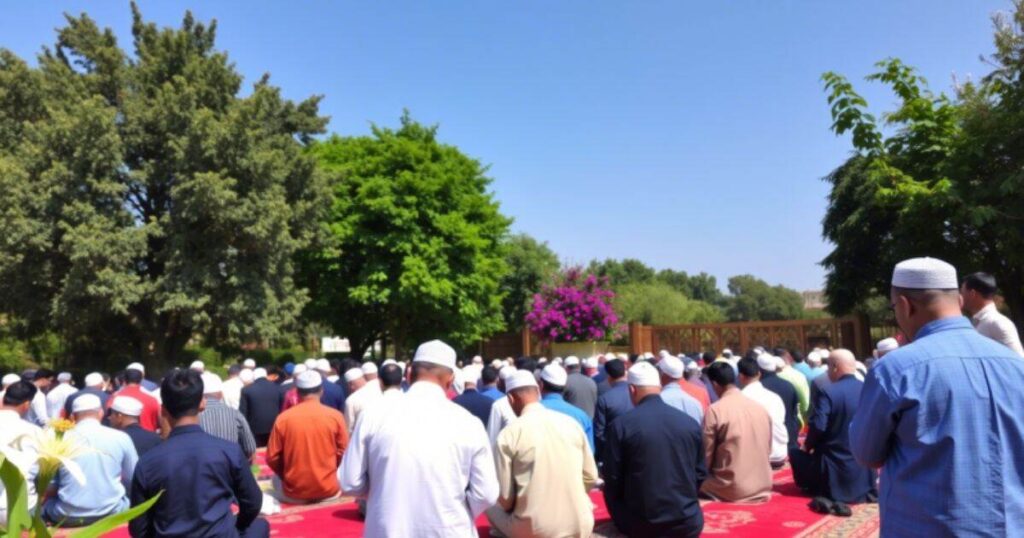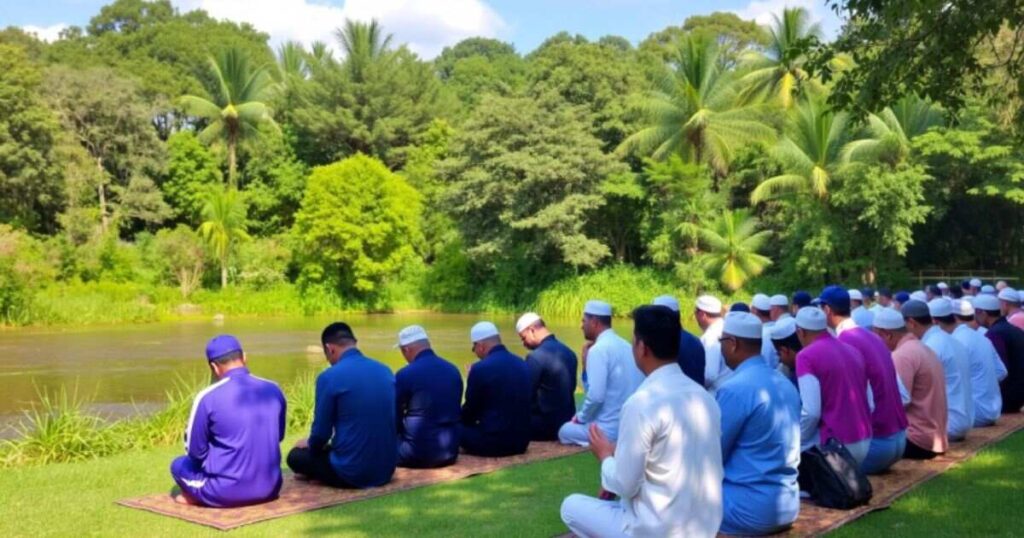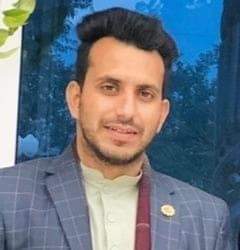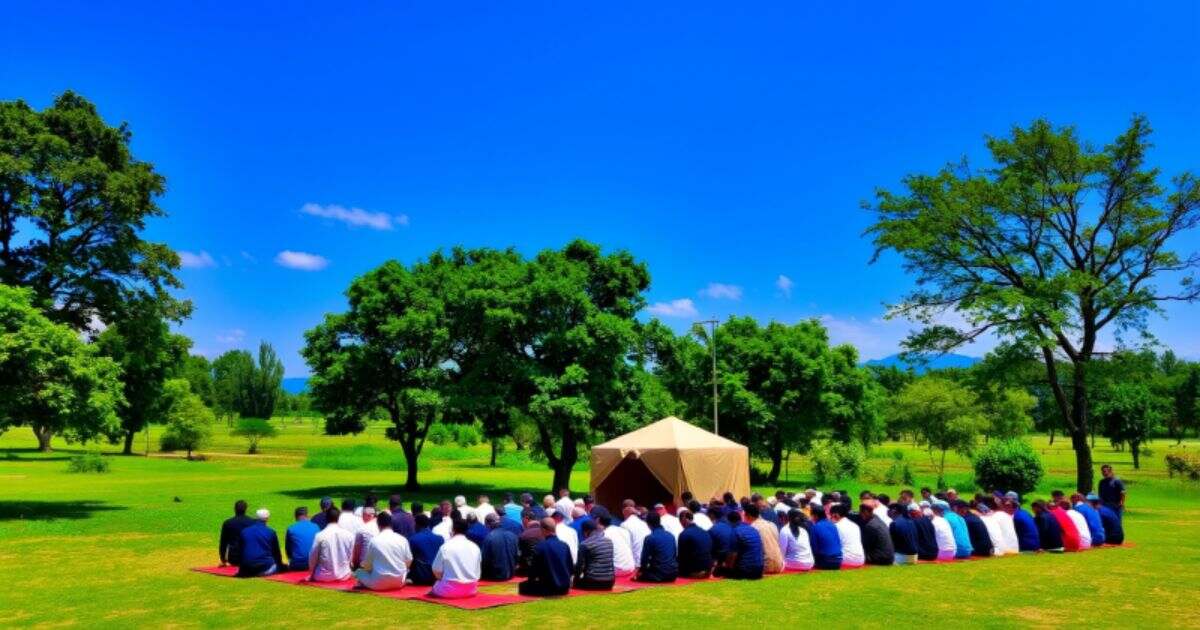Every year, as the first rays of dawn filter through the sky on the days of Eid al Fitr and Eid al Adha, Muslims gather in open fields and mosques across continents for one unifying act of worship: Eid Prayer. While it lasts only a few minutes, this special salah radiates barakah that echoes through families, neighborhoods, and nations. In an age of fragmentation, the communal takbirat, the synchronized prostrations, and the collective supplications remind the Ummah that we are one body diverse yet indivisible. Accordingly, this article explores the profound meaning, etiquette, and global impact of Eid Prayer, showing how the celebration transcends borders and nourishes an enduring spirit of Islamic brotherhood.
Understanding Eid Prayer
Eid Prayer, or Salat al‑Eid, consists of two rak‘ahs performed shortly after sunrise on the mornings of Eid. Unlike the five daily prayers, it features extra takbirat seven in the first rak‘ah and five in the second symbolizing boundless gratitude. Moreover, a concise khutbah follows, urging believers to practice taqwa, charity, and forgiveness. Significantly, the prayer is wajib according to several jurists, underscoring its communal weight. Although brief, Eid encapsulates a year’s worth of hope, repentance, and renewal, setting the tone for festive generosity and spiritual rejuvenation.
Historical Roots: From Madinah to the World
The tradition began in Madinah when Prophet Muhammad led companions to an open plain for the first Eid ul Fitr after Ramadan. As Islam spread from Arabia to Andalusia, Africa, and Asia, the simple practice traveled with merchants, scholars, and migrants. Consequently, whether you stand on Lagos’s Tafawa Balewa Square, London’s Mile End Park, or Kuala Lumpur’s Merdeka Square, the choreography remains identical evidence of the prophetic legacy knitting 1.9 billion hearts. Thus, Eidis both a timeless act of worship and a living symbol of global unity.
Preparing for Eid Prayer: Spiritual and Social Dimensions
Preparation begins the night before. Muslims clip nails, bathe, don their best clothes, and pronounce the takbir after Maghrib: Allahu akbar, Allahu akbar, la ilaha illa Allah These Sunnah acts, though simple, align inner intention with outer appearance. Likewise, fasting on the Day of Arafah or giving fitrah ensures spiritual cleansing and social equity. Importantly, arriving early nurtures humility, while taking alternate routes to and from the prayer ground allows Allah’s angels to witness your devotion. Collectively, these steps transform Eid Prayer into a holistic experience that purifies the soul and unites the community.
Logistics that Enable Global Participation
For Muslim‑minority cities, community organizers liaise with councils to secure parks or stadiums. Volunteers lay carpets, arrange shoe racks, and set up sound systems so even latecomers hear the takbir. In villages, neighbors sweep dusty courtyards and hang buntings. Everywhere, simple logistics facilitate a sacred moment demonstrating that, beyond rituals Celebrations Prayeris community service in motion.
The Global Tapestry of Eid Unity
Across cultures, Eid Prayer weaves unique threads into one tapestry. Indonesians greet each other with “Selamat Hari Raya,” Turks exchange bayramlik sweets, and Senegalese share thiakry pudding. Despite linguistic and culinary diversity, every Muslim utters the same surahs and bows at the same takbir. Therefore, the prayer operates as a spiritual Wi‑Fi, synchronizing hearts in Mecca, Manila, and Minneapolis simultaneously. Moreover, livestreams allow refugees and travelers to feel connected, reinforcing the emotional fabric of a scattered Ummah.
Voices from the Diaspora
Consider Zara, a medical student in Toronto who attends an outdoor Eid Prayer with 25,000 Muslims. Surrounded by strangers yet embraced by familiar recitations, she recalls her grandmother’s village masjid in Lahore. Likewise, Ahmed, a Syrian refugee in Berlin, describes the takbirat as “home itself.” Such testimonies confirm that Celebrations dissolves borders and heals displacement by anchoring identity in faith rather than geography.
Celebrations Etiquette: Sunnah and Best Practices
- Ghusl and Clean Attire Begin with a full bath and your cleanest garments, reflecting inner purification.
- Perfume and a Light Breakfast Apply fragrance and break the Ramadan fast with dates before Eid al‑Fitr; postpone eating until after Eid al Adha sacrifices.
- Takbir en Route Chant silently or aloud while traveling, filling streets with dhikr.
- Separate Prayer Areas Maintain orderly rows so families, singles, and elders all have space.
- Listen Intently to the Khutbah Although sunnah, the sermon offers practical reminders about charity, gratitude, and ongoing taqwa.
- Exchange Greetings Say Taqabbal Allāhu minnā wa minkum .May Allah accept from us and you.
By observing these etiquettes, worshippers transform a communal salah into a catalyst for sustained piety and social cohesion.

Strengthening Brotherhood Beyond the Prayer
Once the final salaam echoes, brotherhood blossoms through shared meals, charity drives, and neighborhood carnivals. Importantly, the spirit of Eid Prayer challenges socioeconomic gaps: affluent families invite orphans, mosques distribute meat parcels, and youth groups clean up litter post event. Furthermore, interfaith neighbors witness Muslim unity and generosity firsthand, dispelling stereotypes. Therefore, Eid Celebrations is not an isolated ritual but a launch pad for twelve months of empathy, volunteerism, and moral excellence.
Incorporating Eid Lessons into Daily Life
Transitioning from celebration to routine can be daunting. However, adopt these practices:
- Daily Takbir Moments Spend two minutes after Fajr echoing Allāhu akbar to retain Eid’s joy.
- Weekly Family Du‘a Circles Rotate leadership so children internalize communal supplication.
- Monthly Charity Goals Pledge a set percentage of income, inspired by Eid zakah and udhiyah.
- Quarterly Community Events Organize clean‑ups or blood drives, extending Eid’s social impact.
Through consistent action, the wisdom of Celebrations Prayerpermeates the calendar, forging resilience and spiritual growth.
Frequently Asked Questions
Q1. Is Eid Prayer obligatory for women?
The majority of scholars encourage women to attend, citing prophetic narrations, though it remains recommended rather than obligatory.
Q2. What time should Celebrations Prayer be performed?
It begins fifteen to twenty minutes after sunrise and should conclude before the sun reaches its zenith.
Q3. How many takbirat are in Celebrations Prayer?
Seven extra takbirat in the first rak‘ah and five in the second, in addition to the standard movements.
Q4. Can Celebrations Prayer be performed indoors?
Yes, if weather or safety restricts outdoor gathering, masjids or halls are permissible.
Q5. What should newcomers know before attending?
Arrive early, dress modestly, follow volunteer directions, and listen attentively to the khutbah.
Q6. Are there differences between Eid al Fitr and Eid al Adha prayers?
Structurally they are the same; however, eating before Fitr and waiting until sacrifice after Adha differ.
Q7. May I perform Celebrations Prayer alone if no congregation exists?
Most scholars permit a solitary prayer following the same structure when no jama‘ah is available.
Q8. What if I miss the takbirat?
Join immediately; missed takbirat are not repeated, and your salah remains valid.
Q9. Does virtual attendance count as Celebrations Prayer?
No. Physical presence is required, though online streams foster connection for those unable to attend.
Q10. How can non‑Muslim friends participate?
Invite them to observe respectfully, share post‑prayer meals, and explain the significance of the celebration.

You may also like:PrayerTechy
Conclusion
In essence, Eid Prayer compresses the Qur’anic ideals of gratitude, unity, and compassion into a single act that reverberates worldwide. From the prophetic Sunnah in seventh‑century Madinah to twenty first century metropolises, its two humble rak‘ahs ignite global brotherhood, reminding Muslims that diversity is our strength and tawhid our anchor. By embracing its etiquette, sharing its blessings, and weaving its lessons into daily routines, the Ummah can transform fleeting festivity into lifelong devotion proving that when hearts prostrate together, borders fade, and the world glimpses true Islamic solidarity.
You may also like:PrayerTechy

Hi I’m Hamza Basharat SEO content writer with 4 years of experience and founder of PrayerTechy.com. I combine faith and strategy to help people discover how to pray with purpose, using well optimized, impactful content rooted in scripture and spiritual growth.



1 thought on “Eid Prayer for the Ummah: Global Islamic Brotherhood”